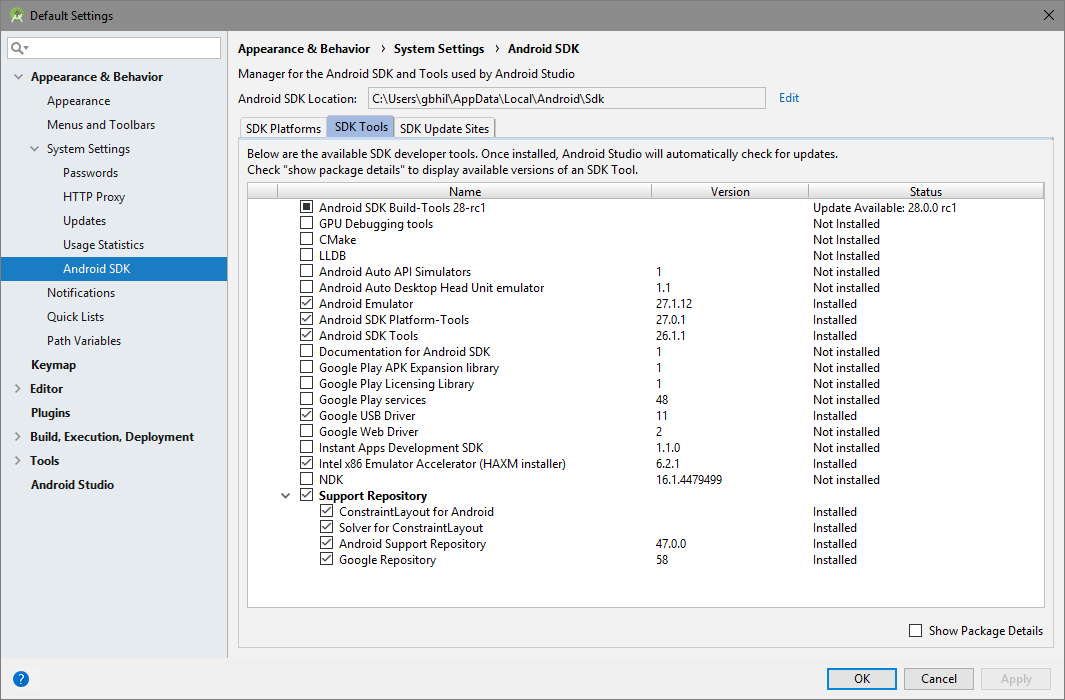Download Android Studio for Mac - A fully-featured and powerful integrated development environment based on IntelliJ IDEA, that delivers Android developer tools for development and debugging. DOWNLOAD Android Studio 4.0.2 / 4.1 RC 3 / 4.2 Canary 13. This enables Disqus. The Android Studio download page auto-detected that I'm running a 64-bit Windows operating system and selected android-studio-ide-1-windows.exe (927 MB) for me to download. Mar 10, 2020 Download the latest version of Android Studio for Mac - Android development platform. Read 4 user reviews of Android Studio on MacUpdate. Aug 25, 2020 As new tools and other APIs become available, Android Studio tells you with a pop-up, or you can check for updates by clicking Help Check for Update. To install Android Studio on your Mac, proceed as follows: Launch the Android Studio DMG file. Drag and drop Android Studio into the Applications folder, then launch Android Studio.

Android Studio is a new IDE for the Android operating system. Launched by Google, it offers new tools for developing apps and is a good alternative to Eclipse, currently the most popular IDE. When you create a new project on Android Studio, the project's structure will appear with almost all the files in one SRC directory. ACID Music Studio. ACID Music Studio is a great music studio software by the industry leaders Sony. It is ideal for the creation of loop-based music, MIDI production, audio recording, studio-quality mixing and so much more. The software is easy to use and thus can be applied by virtually anyone. Installing manually. Download the latest Gradle distribution. The current Gradle release is version 7.2, released on 17 Aug 2021. The distribution zip file comes in two flavors: Binary-only. Complete, with docs and sources. If in doubt, choose the.
Setting up Android Studio takes just a few clicks.
First, be sure you download the latest version of Android Studio.

Windows
To install Android Studio on Windows, proceed as follows:
- If you downloaded an
.exefile (recommended), double-click to launch it.If you downloaded a
.zipfile, unpack the ZIP, copy the android-studio folder into your Program Files folder, and then open the android-studio > bin folder and launchstudio64.exe(for 64-bit machines) orstudio.exe(for 32-bit machines). - Follow the setup wizard in Android Studio and install any SDK packages that it recommends.
That's it.The following video shows each step of the setup procedure when using the recommended.exe download.
As new tools and other APIs become available, Android Studio tells youwith a pop-up, or you can check for updates by clicking Help >Check for Update.
Mac

To install Android Studio on your Mac, proceed as follows:
Android Studio 3.3.1 Download For Mac
- Launch the Android Studio DMG file.
- Drag and drop Android Studio into the Applications folder, then launch Android Studio.
- Select whether you want to import previous Android Studio settings, then click OK.
- The Android Studio Setup Wizard guides you through the rest of the setup, which includes downloading Android SDK components that are required for development.
That's it.The following video shows each step of the recommended setup procedure.
As new tools and other APIs become available, Android Studio tells youwith a pop-up, or you can check for updates by clicking Android Studio> Check for Updates.
Note: If you use Android Studio on macOS Mojave or later, you might see a prompt to allow the IDE to access your calendar, contacts, or photos. This prompt is caused by new privacy protection mechanisms for applications that access files under the home directory. So, if your project includes files and libraries in your home directory, and you see this prompt, you can select Don't Allow.
Linux
To install Android Studio on Linux, proceed as follows:
Android Software Development Kit
- Unpack the
.zipfile you downloaded to an appropriate location for your applications, such as within/usr/local/for your user profile, or/opt/for shared users.If you're using a 64-bit version of Linux, make sure you first install the required libraries for 64-bit machines.
- To launch Android Studio, open a terminal, navigate to the
android-studio/bin/directory, and executestudio.sh. - Select whether you want to import previous Android Studio settings or not, then click OK.
- The Android Studio Setup Wizard guides you through the rest of the setup, which includes downloading Android SDK components that are required for development.
Tip:To make Android Studio available in your list of applications, selectTools > Create Desktop Entry from the Android Studio menu bar.
Required libraries for 64-bit machines
Android Studio 3.2.1 Download Mac 10.13
If you are running a 64-bit version of Ubuntu, you need to install some 32-bitlibraries with the following command:
If you are running 64-bit Fedora, the command is:
That's it.The following video shows each step of the recommended setup procedure.

As new tools and other APIs become available, Android Studio tells youwith a pop-up, or you can check for updates by clicking Help >Check for Update.
Android Studio 3.2.1 Download Mac Download
Chrome OS
Follow these steps to install Android Studio on Chrome OS:
Android Studio 3.2.1 Download Mac Download
Windows 10 Download Android Studio
- If you haven't already done so, install Linux for Chrome OS.
- Open the Files app and locate the DEB package you downloaded in theDownloads folder under My files.
Right-click the DEB package and select Install with Linux (Beta).
- If you have installed Android Studio before, select whether you want toimport previous Android Studio settings, then click OK.
The Android Studio Setup Wizard guides you through the rest of thesetup, which includes downloading Android SDK components that arerequired for development.
After installation is complete, launch Android Studio either from theLauncher, or from the Chrome OS Linux terminal by running
studio.shinthe default installation directory:/opt/android-studio/bin/studio.sh
That's it. As new tools and other APIs become available, Android Studio tells youwith a pop-up, or you can check for updates by clicking Help >Check for Update.
Note:Download Free Android Studio
Android Studio on Chrome OS currently supports deploying your app only toa connected hardware device. To learn more, read Run apps on a hardwaredevice.Technical docs > Configuring Android Studio: IDE & VM Options, JDK, etc > Mac OSX JDK Selection
|